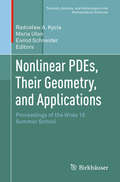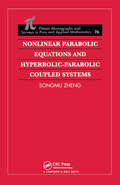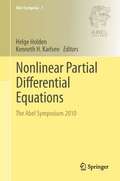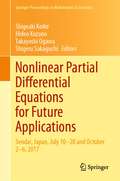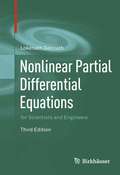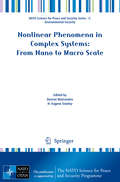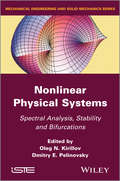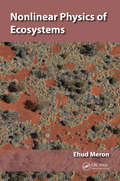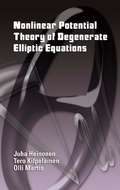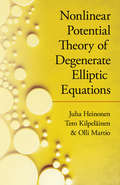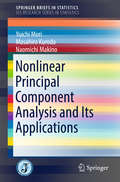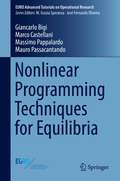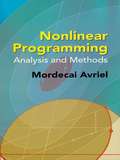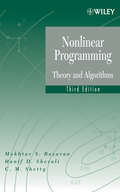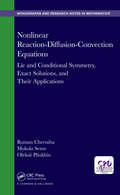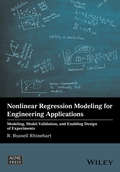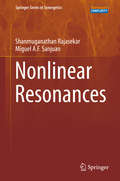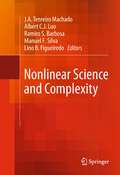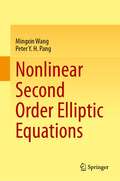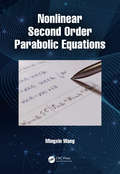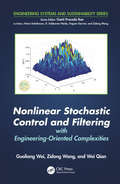- Table View
- List View
Nonlinear PDEs, Their Geometry, and Applications: Proceedings of the Wisła 18 Summer School (Tutorials, Schools, and Workshops in the Mathematical Sciences)
by Radosław A. Kycia Maria Ułan Eivind SchneiderThis volume presents lectures given at the Summer School Wisła 18: Nonlinear PDEs, Their Geometry, and Applications, which took place from August 20 - 30th, 2018 in Wisła, Poland, and was organized by the Baltic Institute of Mathematics. The lectures in the first part of this volume were delivered by experts in nonlinear differential equations and their applications to physics. Original research articles from members of the school comprise the second part of this volume. Much of the latter half of the volume complements the methods expounded in the first half by illustrating additional applications of geometric theory of differential equations. Various subjects are covered, providing readers a glimpse of current research. Other topics covered include thermodynamics, meteorology, and the Monge–Ampère equations.Researchers interested in the applications of nonlinear differential equations to physics will find this volume particularly useful. A knowledge of differential geometry is recommended for the first portion of the book, as well as a familiarity with basic concepts in physics.
Nonlinear Parabolic Equations and Hyperbolic-Parabolic Coupled Systems (Monographs And Surveys In Pure And Applied Math #76)
by Songmu ZhengThis monograph is devoted to the global existence, uniqueness and asymptotic behaviour of smooth solutions to both initial value problems and initial boundary value problems for nonlinear parabolic equations and hyperbolic parabolic coupled systems. Most of the material is based on recent research carried out by the author and his collaborators.The book can be divided into two parts. In the first part, the results on decay of solutions to nonlinear parabolic equations and hyperbolic parabolic coupled systems are obtained, and a chapter is devoted to the global existence of small smooth solutions to fully nonlinear parabolic equations and quasilinear hyperbolic parabolic coupled systems. Applications of the results to nonlinear thermoelasticity and fluid dynamics are also shown.Some nonlinear parabolic equations and coupled systems arising from the study of phase transitions are investigated in the second part of the book. The global existence, uniqueness and asymptotic behaviour of smooth solutions with arbitrary initial data are obtained. The final chapter is further devoted to related topics: multiplicity of equilibria and the existence of a global attractor, inertial manifold and inertial set.A knowledge of partial differential equations and Sobolev spaces is assumed. As an aid to the reader, the related concepts and results are collected and the relevant references given in the firstchapter. The work will be of interest to researchers and graduate students in pure and applied mathematics, mathematical physics and applied sciences.
Nonlinear Parameter Optimization Using R Tools
by John C. NashNonlinear Parameter Optimization Using RJohn C. Nash, Telfer School of Management, University of Ottawa, CanadaA systematic and comprehensive treatment of optimization software using RIn recent decades, optimization techniques have been streamlined by computational and artificial intelligence methods to analyze more variables, especially under non-linear, multivariable conditions, more quickly than ever before.Optimization is an important tool for decision science and for the analysis of physical systems used in engineering. Nonlinear Parameter Optimization with R explores the principal tools available in R for function minimization, optimization, and nonlinear parameter determination and features numerous examples throughout.Nonlinear Parameter Optimization with R:* Provides a comprehensive treatment of optimization techniques* Examines optimization problems that arise in statistics and how to solve them using R* Enables researchers and practitioners to solve parameter determination problems* Presents traditional methods as well as recent developments in R* Is supported by an accompanying website featuring R code, examples and datasetsResearchers and practitioners who have to solve parameter determination problems who are users of R but are novices in the field optimization or function minimization will benefit from this book. It will also be useful for scientists building and estimating nonlinear models in various fields such as hydrology, sports forecasting, ecology, chemical engineering, pharmaco-kinetics, agriculture, economics and statistics.
Nonlinear Partial Differential Equations
by Kenneth H. Karlsen Helge HoldenThe topic of the 2010 Abel Symposium, hosted at the Norwegian Academy of Science and Letters, Oslo, was Nonlinear Partial Differential Equations, the study of which is of fundamental importance in mathematics and in almost all of natural sciences, economics, and engineering. This area of mathematics is currently in the midst of an unprecedented development worldwide. Differential equations are used to model phenomena of increasing complexity, and in areas that have traditionally been outside the realm of mathematics. New analytical tools and numerical methods are dramatically improving our understanding of nonlinear models. Nonlinearity gives rise to novel effects reflected in the appearance of shock waves, turbulence, material defects, etc., and offers challenging mathematical problems. On the other hand, new mathematical developments provide new insight in many applications. These proceedings present a selection of the latest exciting results by world leading researchers.
Nonlinear Partial Differential Equations for Future Applications: Sendai, Japan, July 10–28 and October 2–6, 2017 (Springer Proceedings in Mathematics & Statistics #346)
by Shigeru Sakaguchi Hideo Kozono Shigeaki Koike Takayoshi OgawaThis volume features selected, original, and peer-reviewed papers on topics from a series of workshops on Nonlinear Partial Differential Equations for Future Applications that were held in 2017 at Tohoku University in Japan. The contributions address an abstract maximal regularity with applications to parabolic equations, stability, and bifurcation for viscous compressible Navier–Stokes equations, new estimates for a compressible Gross–Pitaevskii–Navier–Stokes system, singular limits for the Keller–Segel system in critical spaces, the dynamic programming principle for stochastic optimal control, two kinds of regularity machineries for elliptic obstacle problems, and new insight on topology of nodal sets of high-energy eigenfunctions of the Laplacian. This book aims to exhibit various theories and methods that appear in the study of nonlinear partial differential equations.
Nonlinear Partial Differential Equations for Scientists and Engineers
by Lokenath DebnathThe revised and enlarged third edition of this successful book presents a comprehensive and systematic treatment of linear and nonlinear partial differential equations and their varied and updated applications. In an effort to make the book more useful for a diverse readership, updated modern examples of applications are chosen from areas of fluid dynamics, gas dynamics, plasma physics, nonlinear dynamics, quantum mechanics, nonlinear optics, acoustics, and wave propagation. Nonlinear Partial Differential Equations for Scientists and Engineers, Third Edition, improves on an already highly complete and accessible resource for graduate students and professionals in mathematics, physics, science, and engineering. It may be used to great effect as a course textbook, research reference, or self-study guide.
Nonlinear Partial Differential Equations in Engineering and Applied Science: Volume 54 (Lecture Notes in Pure and Applied Mathematics #54)
by ROBERT L. STERNBERG, ANTHONY J. KALINOWSKI AND JOHN S. PAPADAKISIn this volume are twenty-eight papers from the Conference on Nonlinear Partial Differential Equationsin Engineering and Applied Science, sponsored by the Office of Naval Research and held at the Universityof Rhode Island in June, 1979. Included are contributions from an international group of distinguishedmathematicians, scientists, and engineers coming from a wide variety of disciplines and having a commoninterest in the application of mathematics, particularly nonlinear partial differential equations, to realworld problems.The subject matter ranges from almost purely mathematical topics in numerical analysis and bifurcationtheory to a host of practical applications that involve nonlinear partial differential equations, suchas fluid dynamics, nonlinear waves, elasticity, viscoelasticity, hyperelasticity, solitons, metallurgy, shocklessairfoil design, quantum fields, and Darcy's law on flows in porous media.Non/inear Partial Differential Equations in Engineering and Applied Science focuses on a variety oftopics of specialized, contemporary concern to mathematicians, physical and biological scientists, andengineers who work with phenomena that can be described by nonlinear partial differential equations.
Nonlinear Phenomena in Complex Systems: From Nano to Macro Scale
by Davron Matrasulov H. Eugene StanleyTopics of complex system physics and their interdisciplinary applications to different problems in seismology, biology, economy, sociology, energy and nanotechnology are covered in this new work from renowned experts in their fields. In particular, contributed papers contain original results on network science, earthquake dynamics, econophysics, sociophysics, nanoscience and biological physics. Most of the papers use interdisciplinary approaches based on statistical physics, quantum physics and other topics of complex system physics. Papers on econophysics and sociophysics are focussed on societal aspects of physics such as, opinion dynamics, public debates and financial and economic stability. This work will be of interest to statistical physicists, economists, biologists, seismologists and all scientists working in interdisciplinary topics of complexity.
Nonlinear Physical Systems: Spectral Analysis, Stability and Bifurcations
by Oleg N. Kirillov Dmitry E. PelinovskyBringing together 18 chapters written by leading experts in dynamical systems, operator theory, partial differential equations, and solid and fluid mechanics, this book presents state-of-the-art approaches to a wide spectrum of new and challenging stability problems. Nonlinear Physical Systems: Spectral Analysis, Stability and Bifurcations focuses on problems of spectral analysis, stability and bifurcations arising in the nonlinear partial differential equations of modern physics. Bifurcations and stability of solitary waves, geometrical optics stability analysis in hydro- and magnetohydrodynamics, and dissipation-induced instabilities are treated with the use of the theory of Krein and Pontryagin space, index theory, the theory of multi-parameter eigenvalue problems and modern asymptotic and perturbative approaches. Each chapter contains mechanical and physical examples, and the combination of advanced material and more tutorial elements makes this book attractive for both experts and non-specialists keen to expand their knowledge on modern methods and trends in stability theory. Contents 1. Surprising Instabilities of Simple Elastic Structures, Davide Bigoni, Diego Misseroni, Giovanni Noselli and Daniele Zaccaria. 2. WKB Solutions Near an Unstable Equilibrium and Applications, Jean-François Bony, Setsuro Fujiié, Thierry Ramond and Maher Zerzeri, partially supported by French ANR project NOSEVOL. 3. The Sign Exchange Bifurcation in a Family of Linear Hamiltonian Systems, Richard Cushman, Johnathan Robbins and Dimitrii Sadovskii. 4. Dissipation Effect on Local and Global Fluid-Elastic Instabilities, Olivier Doaré. 5. Tunneling, Librations and Normal Forms in a Quantum Double Well with a Magnetic Field, Sergey Yu. Dobrokhotov and Anatoly Yu. Anikin. 6. Stability of Dipole Gap Solitons in Two-Dimensional Lattice Potentials, Nir Dror and Boris A. Malomed. 7. Representation of Wave Energy of a Rotating Flow in Terms of the Dispersion Relation, Yasuhide Fukumoto, Makoto Hirota and Youichi Mie. 8. Determining the Stability Domain of Perturbed Four-Dimensional Systems in 1:1 Resonance, Igor Hoveijn and Oleg N. Kirillov. 9. Index Theorems for Polynomial Pencils, Richard Kollár and Radomír Bosák. 10. Investigating Stability and Finding New Solutions in Conservative Fluid Flows Through Bifurcation Approaches, Paolo Luzzatto-Fegiz and Charles H.K. Williamson. 11. Evolution Equations for Finite Amplitude Waves in Parallel Shear Flows, Sherwin A. Maslowe. 12. Continuum Hamiltonian Hopf Bifurcation I, Philip J. Morrison and George I. Hagstrom. 13. Continuum Hamiltonian Hopf Bifurcation II, George I. Hagstrom and Philip J. Morrison. 14. Energy Stability Analysis for a Hybrid Fluid-Kinetic Plasma Model, Philip J. Morrison, Emanuele Tassi and Cesare Tronci. 15. Accurate Estimates for the Exponential Decay of Semigroups with Non-Self-Adjoint Generators, Francis Nier. 16. Stability Optimization for Polynomials and Matrices, Michael L. Overton. 17. Spectral Stability of Nonlinear Waves in KdV-Type Evolution Equations, Dmitry E. Pelinovsky. 18. Unfreezing Casimir Invariants: Singular Perturbations Giving Rise to Forbidden Instabilities, Zensho Yoshida and Philip J. Morrison. About the Authors Oleg N. Kirillov has been a Research Fellow at the Magneto-Hydrodynamics Division of the Helmholtz-Zentrum Dresden-Rossendorf in Germany since 2011. His research interests include non-conservative stability problems of structural mechanics and physics, perturbation theory of non-self-adjoint boundary eigenvalue problems, magnetohydrodynamics, friction-induced oscillations, dissipation-induced instabilities and non-Hermitian problems of optics and microwave physics. Since 2013 he has served as an Associate Editor fo
Nonlinear Physics of Ecosystems
by Ehud MeronNonlinear Physics of Ecosystems introduces the concepts and tools of pattern formation theory and demonstrates their utility in ecological research using problems from spatial ecology. Written in language understandable to both physicists and ecologists in most parts, the book reveals the mechanisms of pattern formation and pattern dynamics. It als
Nonlinear Potential Theory of Degenerate Elliptic Equations (Dover Books on Mathematics)
by Juha Heinonen Tero Kilpeläinen Olli MartioA self-contained treatment appropriate for advanced undergraduates and graduate students, this text offers a detailed development of the necessary background for its survey of the nonlinear potential theory of superharmonic functions.Starting with the theory of weighted Sobolev spaces, this treatment advances to the theory of weighted variational capacity. Succeeding chapters investigate solutions and supersolutions of equations, with emphasis on refined Sobolev spaces, variational integrals, and harmonic functions. Chapter 7 defines superharmonic functions via the comparison principle, and chapters 8 through 14 form the core of the nonlinear potential theory of superharmonic functions. Topics include balayage; Perron's method, barriers, and resolutivity; polar sets; harmonic measure; fine topology; harmonic morphisms; and quasiregular mappings. The text concludes with explorations of axiomatic nonlinear potential theory and helpful appendixes.
Nonlinear Potential Theory of Degenerate Elliptic Equations (Dover Books on Mathematics)
by Juha Heinonen Olli Martio Tero KipelainenA self-contained treatment appropriate for advanced undergraduate and graduate students, this volume offers a detailed development of the necessary background for its survey of the nonlinear potential theory of superharmonic functions.Starting with the theory of weighted Sobolev spaces, the text advances to the theory of weighted variational capacity. Succeeding chapters investigate solutions and supersolutions of equations, with emphasis on refined Sobolev spaces, variational integrals, and harmonic functions. Chapter 7 defines superharmonic functions via the comparison principle, and chapters 8 through 14 form the core of the nonlinear potential theory of superharmonic functions. Topics include balayage; Perron's method, barriers, and resolutivity; polar sets; harmonic measure; fine topology; harmonic morphisms; and quasiregular mappings. The book concludes with explorations of axiomatic nonlinear potential theory and helpful appendixes.
Nonlinear Principal Component Analysis and Its Applications
by Yuichi Mori Masahiro Kuroda Naomichi MakinoThis book expounds the principle and related applications of nonlinear principal component analysis (PCA), which is useful method to analyze mixed measurement levels data. In the part dealing with the principle, after a brief introduction of ordinary PCA, a PCA for categorical data (nominal and ordinal) is introduced as nonlinear PCA, in which an optimal scaling technique is used to quantify the categorical variables. The alternating least squares (ALS) is the main algorithm in the method. Multiple correspondence analysis (MCA), a special case of nonlinear PCA, is also introduced. All formulations in these methods are integrated in the same manner as matrix operations. Because any measurement levels data can be treated consistently as numerical data and ALS is a very powerful tool for estimations, the methods can be utilized in a variety of fields such as biometrics, econometrics, psychometrics, and sociology. In the applications part of the book, four applications are introduced: variable selection for mixed measurement levels data, sparse MCA, joint dimension reduction and clustering methods for categorical data, and acceleration of ALS computation. The variable selection methods in PCA that originally were developed for numerical data can be applied to any types of measurement levels by using nonlinear PCA. Sparseness and joint dimension reduction and clustering for nonlinear data, the results of recent studies, are extensions obtained by the same matrix operations in nonlinear PCA. Finally, an acceleration algorithm is proposed to reduce the problem of computational cost in the ALS iteration in nonlinear multivariate methods. This book thus presents the usefulness of nonlinear PCA which can be applied to different measurement levels data in diverse fields. As well, it covers the latest topics including the extension of the traditional statistical method, newly proposed nonlinear methods, and computational efficiency in the methods.
Nonlinear Programming Techniques for Equilibria (EURO Advanced Tutorials on Operational Research)
by Giancarlo Bigi Marco Castellani Massimo Pappalardo Mauro PassacantandoThis book considers a range of problems in operations research, which are formulated through various mathematical models such as complementarity, variational inequalities, multiobjective optimization, fixed point problems, noncooperative games and inverse optimization. Moreover, the book subsumes all these models under a common structure that allows them to be formulated in a unique format: the Ky Fan inequality. It subsequently focuses on this unifying equilibrium format, providing a comprehensive overview of the main theoretical results and solution algorithms, together with a wealth of applications and numerical examples. Particular emphasis is placed on the role of nonlinear optimization techniques – e.g. convex optimization, nonsmooth calculus, proximal point and descent algorithms – as valuable tools for analyzing and solving Ky Fan inequalities.
Nonlinear Programming: Analysis and Methods
by Mordecai AvrielComprehensive and complete, this overview provides a single-volume treatment of key algorithms and theories. The author provides clear explanations of all theoretical aspects, with rigorous proof of most results. The two-part treatment begins with the derivation of optimality conditions and discussions of convex programming, duality, generalized convexity, and analysis of selected nonlinear programs. The second part concerns techniques for numerical solutions and unconstrained optimization methods, and it presents commonly used algorithms for constrained nonlinear optimization problems. This graduate-level text requires no advanced mathematical background beyond elementary calculus, linear algebra, and real analysis. 1976 edition. 58 figures. 7 tables.
Nonlinear Programming: Theory and Algorithms
by Hanif D. Sherali Mokhtar S. Bazaraa C. M. ShettyCOMPREHENSIVE COVERAGE OF NONLINEAR PROGRAMMING THEORY AND ALGORITHMS, THOROUGHLY REVISED AND EXPANDEDNonlinear Programming: Theory and Algorithms--now in an extensively updated Third Edition--addresses the problem of optimizing an objective function in the presence of equality and inequality constraints. Many realistic problems cannot be adequately represented as a linear program owing to the nature of the nonlinearity of the objective function and/or the nonlinearity of any constraints. The Third Edition begins with a general introduction to nonlinear programming with illustrative examples and guidelines for model construction.Concentration on the three major parts of nonlinear programming is provided:Convex analysis with discussion of topological properties of convex sets, separation and support of convex sets, polyhedral sets, extreme points and extreme directions of polyhedral sets, and linear programmingOptimality conditions and duality with coverage of the nature, interpretation, and value of the classical Fritz John (FJ) and the Karush-Kuhn-Tucker (KKT) optimality conditions; the interrelationships between various proposed constraint qualifications; and Lagrangian duality and saddle point optimality conditionsAlgorithms and their convergence, with a presentation of algorithms for solving both unconstrained and constrained nonlinear programming problemsImportant features of the Third Edition include:New topics such as second interior point methods, nonconvex optimization, nondifferentiable optimization, and moreUpdated discussion and new applications in each chapterDetailed numerical examples and graphical illustrationsEssential coverage of modeling and formulating nonlinear programsSimple numerical problemsAdvanced theoretical exercisesThe book is a solid reference for professionals as well as a useful text for students in the fields of operations research, management science, industrial engineering, applied mathematics, and also in engineering disciplines that deal with analytical optimization techniques. The logical and self-contained format uniquely covers nonlinear programming techniques with a great depth of information and an abundance of valuable examples and illustrations that showcase the most current advances in nonlinear problems.
Nonlinear Reaction-Diffusion-Convection Equations: Lie and Conditional Symmetry, Exact Solutions and Their Applications (Chapman & Hall/CRC Monographs and Research Notes in Mathematics)
by Roman Cherniha Mykola Serov Oleksii PliukhinIt is well known that symmetry-based methods are very powerful tools for investigating nonlinear partial differential equations (PDEs), notably for their reduction to those of lower dimensionality (e.g. to ODEs) and constructing exact solutions. This book is devoted to (1) search Lie and conditional (non-classical) symmetries of nonlinear RDC equations, (2) constructing exact solutions using the symmetries obtained, and (3) their applications for solving some biologically and physically motivated problems. The book summarises the results derived by the authors during the last 10 years and those obtained by some other authors.
Nonlinear Regression Modeling for Engineering Applications: Modeling, Model Validation, and Enabling Design of Experiments
by R. Russell RhinehartSince mathematical models express our understanding of how nature behaves, we use them to validate our understanding of the fundamentals about systems (which could be processes, equipment, procedures, devices, or products). Also, when validated, the model is useful for engineering applications related to diagnosis, design, and optimization. First, we postulate a mechanism, then derive a model grounded in that mechanistic understanding. If the model does not fit the data, our understanding of the mechanism was wrong or incomplete. Patterns in the residuals can guide model improvement. Alternately, when the model fits the data, our understanding is sufficient and confidently functional for engineering applications. This book details methods of nonlinear regression, computational algorithms,model validation, interpretation of residuals, and useful experimental design. The focus is on practical applications, with relevant methods supported by fundamental analysis. This book will assist either the academic or industrial practitioner to properly classify the system, choose between the various available modeling options and regression objectives, design experiments to obtain data capturing critical system behaviors, fit the model parameters based on that data, and statistically characterize the resulting model. The author has used the material in the undergraduate unit operations lab course and in advanced control applications.
Nonlinear Resonances
by Shanmuganathan Rajasekar Miguel A.F. SanjuanThis introductory text presents the basic aspects and most important features of various types of resonances and anti-resonances in dynamical systems. In particular, for each resonance, it covers the theoretical concepts, illustrates them with case studies, and reviews the available information on mechanisms, characterization, numerical simulations, experimental realizations, possible quantum analogues, applications and significant advances made over the years. Resonances are one of the most fundamental phenomena exhibited by nonlinear systems and refer to specific realizations of maximum response of a system due to the ability of that system to store and transfer energy received from an external forcing source. Resonances are of particular importance in physical, engineering and biological systems - they can prove to be advantageous in many applications, while leading to instability and even disasters in others. The book is self-contained, providing the details of mathematical derivations and techniques involved in numerical simulations. Though primarily intended for graduate students, it can also be considered a reference book for any researcher interested in the dynamics of resonant phenomena.
Nonlinear Science and Complexity
by Albert C. Luo J.A. Tenreiro Machado Lino B. Figueiredo Manuel F. Silva Ramiro S. BarbosaThis book contains selected papers of NSC08, the 2nd Conference on Nonlinear Science and Complexity, held 28-31 July, 2008, Porto, Portugal. It focuses on fundamental theories and principles, analytical and symbolic approaches, computational techniques in nonlinear physics and mathematics. Topics treated include * Chaotic Dynamics and Transport in Classic and Quantum Systems * Complexity and Nonlinearity in Molecular Dynamics and Nano-Science * Complexity and Fractals in Nonlinear Biological Physics and Social Systems * Lie Group Analysis and Applications in Nonlinear Science * Nonlinear Hydrodynamics and Turbulence * Bifurcation and Stability in Nonlinear Dynamic Systems * Nonlinear Oscillations and Control with Applications * Celestial Physics and Deep Space Exploration * Nonlinear Mechanics and Nonlinear Structural Dynamics * Non-smooth Systems and Hybrid Systems * Fractional dynamical systems
Nonlinear Second Order Elliptic Equations
by Mingxin Wang Peter Y. PangThis book focuses on the following three topics in the theory of boundary value problems of nonlinear second order elliptic partial differential equations and systems: (i) eigenvalue problem, (ii) upper and lower solutions method, (iii) topological degree method, and deals with the existence of solutions, more specifically non-constant positive solutions, as well as the uniqueness, stability and asymptotic behavior of such solutions.While not all-encompassing, these topics represent major approaches to the theory of partial differential equations and systems, and should be of significant interest to graduate students and researchers. Two appendices have been included to provide a good gauge of the prerequisites for this book and make it reasonably self-contained.A notable strength of the book is that it contains a large number of substantial examples. Exercises for the reader are also included. Therefore, this book is suitable as a textbook for graduate students who havealready had an introductory course on PDE and some familiarity with functional analysis and nonlinear functional analysis, and as a reference for researchers.
Nonlinear Second Order Parabolic Equations
by Mingxin WangThe parabolic partial differential equations model one of the most important processes in the real-world: diffusion. Whether it is the diffusion of energy in space-time, the diffusion of species in ecology, the diffusion of chemicals in biochemical processes, or the diffusion of information in social networks, diffusion processes are ubiquitous and crucial in the physical and natural world as well as our everyday lives. This book is self-contained and covers key topics such as theory and Schauder theory, maximum principle, comparison principle, regularity and uniform estimates, initial-boundary value problems of semilinear parabolic scalar equations and weakly coupled parabolic systems, the upper and lower solutions method, monotone properties and long-time behaviours of solutions, convergence of solutions and stability of equilibrium solutions, global solutions and finite time blowup. It also touches on periodic boundary value problems, free boundary problems, and semigroup theory. The book covers major theories and methods of the field, including topics that are useful but hard to find elsewhere. This book is based on tried and tested teaching materials used at the Harbin Institute of Technology over the past ten years. Special care was taken to make the book suitable for classroom teaching as well as for self-study among graduate students. About the Author: Mingxin Wang is Professor of Mathematics at Harbin Institute of Technology, China. He has published ten monographs and textbooks and 260 papers. He is also a supervisor of 30 PhD students.
Nonlinear Solid Mechanics For Finite Element Analysis: Statics
by Javier Bonet Antonio J. Gil Richard D. WoodDesigning engineering components that make optimal use of materials requires consideration of the nonlinear static and dynamic characteristics associated with both manufacturing and working environments. The modeling of these characteristics can only be done through numerical formulation and simulation, which requires an understanding of both the theoretical background and associated computer solution techniques. By presenting both the nonlinear solid mechanics and the associated finite element techniques together, the authors provide, in the first of two books in this series, a complete, clear, and unified treatment of the static aspects of nonlinear solid mechanics. Alongside a range of worked examples and exercises are user instructions, program descriptions, and examples for the FLagSHyP MATLAB computer implementation, for which the source code is available online. While this book is designed to complement postgraduate courses, it is also relevant to those in industry requiring an appreciation of the way their computer simulation programs work.
Nonlinear Solid Mechanics: Bifurcation Theory and Material Instability
by Davide BigoniThis book covers solid mechanics for non-linear elastic and elastoplastic materials, describing the behaviour of ductile material subject to extreme mechanical loading and its eventual failure. The book highlights constitutive features to describe the behaviour of frictional materials such as geological media. On the basis of this theory, including large strain and inelastic behaviours, bifurcation and instability are developed with a special focus on the modelling of the emergence of local instabilities such as shear band formation and flutter of a continuum. The former is regarded as a precursor of fracture, while the latter is typical of granular materials. The treatment is complemented with qualitative experiments, illustrations from everyday life and simple examples taken from structural mechanics.
Nonlinear Stochastic Control and Filtering with Engineering-oriented Complexities (Engineering Systems and Sustainability #2)
by Zidong Wang Guoliang Wei Wei QianNonlinear Stochastic Control and Filtering with Engineering-oriented Complexities presents a series of control and filtering approaches for stochastic systems with traditional and emerging engineering-oriented complexities. The book begins with an overview of the relevant background, motivation, and research problems, and then: Discusses the robust stability and stabilization problems for a class of stochastic time-delay interval systems with nonlinear disturbances Investigates the robust stabilization and H∞ control problems for a class of stochastic time-delay uncertain systems with Markovian switching and nonlinear disturbances Explores the H∞ state estimator and H∞ output feedback controller design issues for stochastic time-delay systems with nonlinear disturbances, sensor nonlinearities, and Markovian jumping parameters Analyzes the H∞ performance for a general class of nonlinear stochastic systems with time delays, where the addressed systems are described by general stochastic functional differential equations Studies the filtering problem for a class of discrete-time stochastic nonlinear time-delay systems with missing measurement and stochastic disturbances Uses gain-scheduling techniques to tackle the probability-dependent control and filtering problems for time-varying nonlinear systems with incomplete information Evaluates the filtering problem for a class of discrete-time stochastic nonlinear networked control systems with multiple random communication delays and random packet losses Examines the filtering problem for a class of nonlinear genetic regulatory networks with state-dependent stochastic disturbances and state delays Considers the H∞ state estimation problem for a class of discrete-time complex networks with probabilistic missing measurements and randomly occurring coupling delays Addresses the H∞ synchronization control problem for a class of dynamical networks with randomly varying nonlinearities Nonlinear Stochastic Control and Filtering with Engineering-oriented Complexities describes novel methodologies that can be applied extensively in lab simulations, field experiments, and real-world engineering practices. Thus, this text provides a valuable reference for researchers and professionals in the signal processing and control engineering communities.
